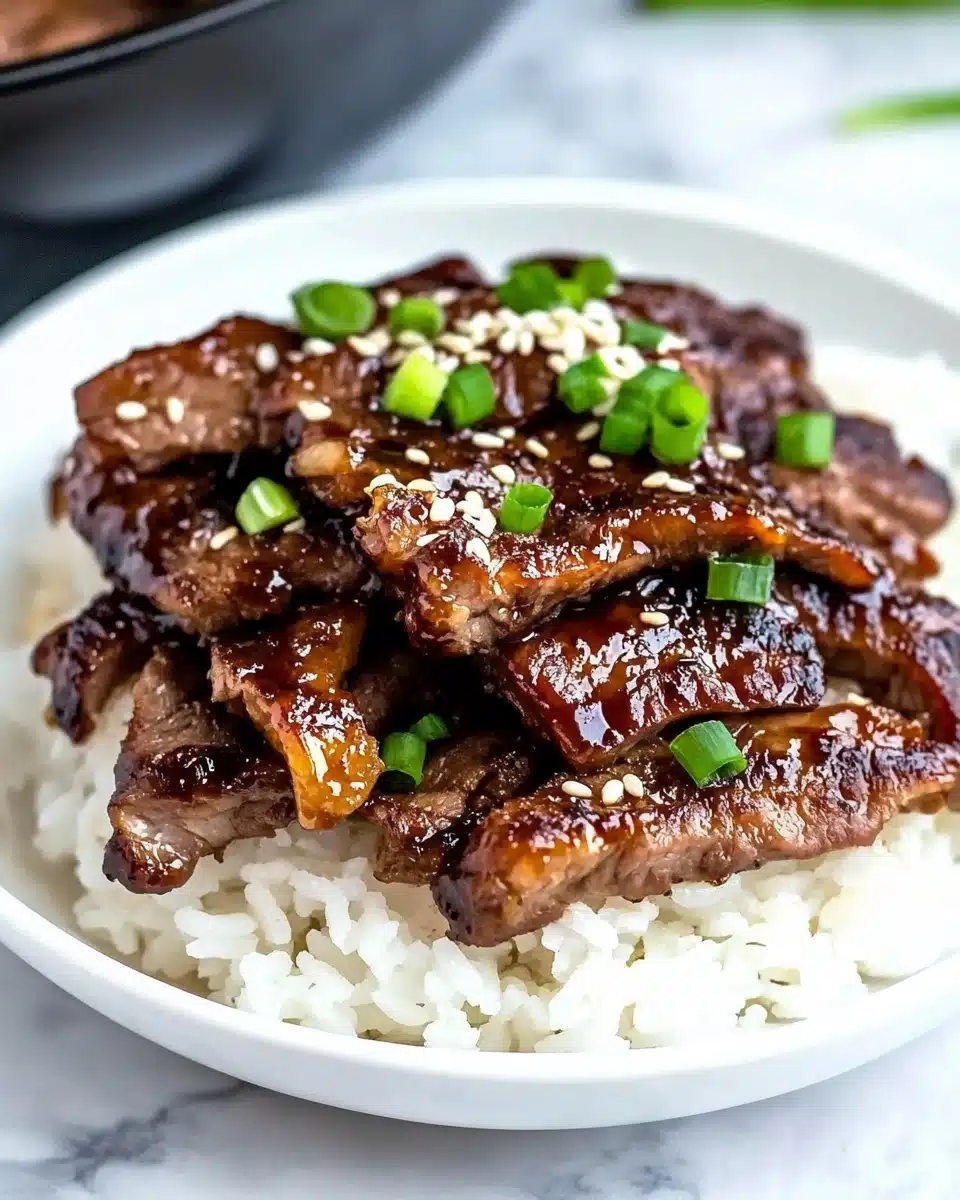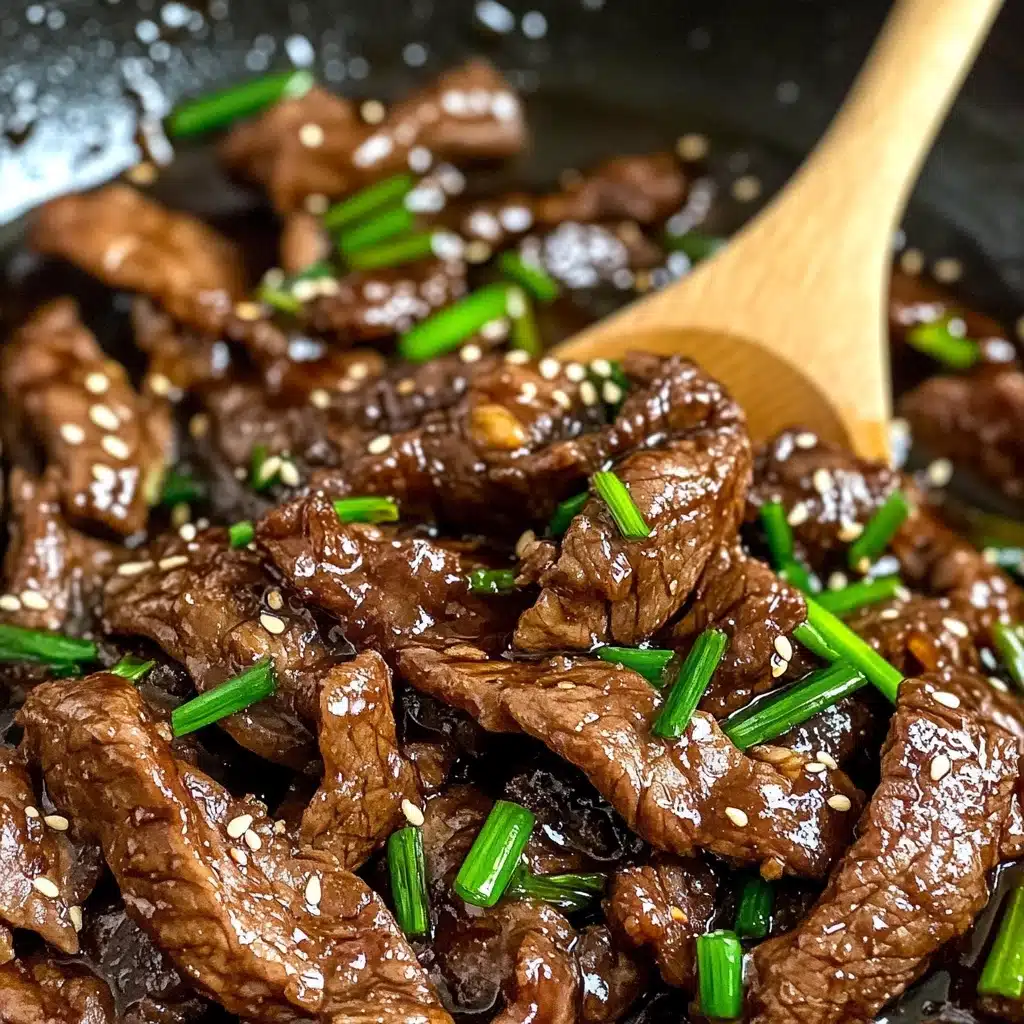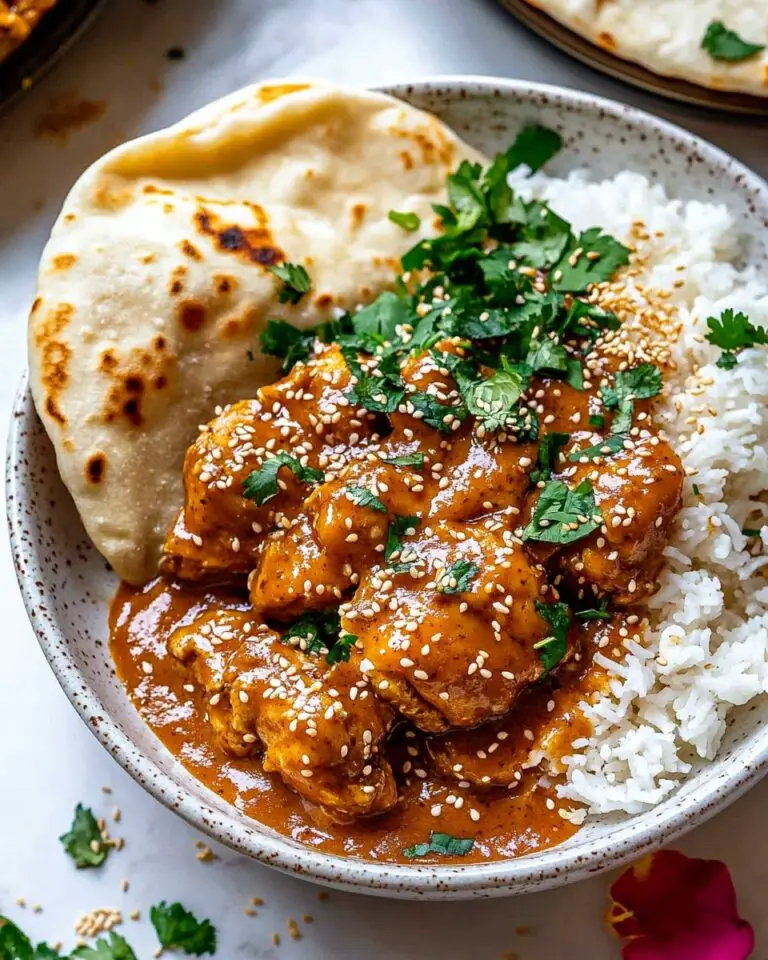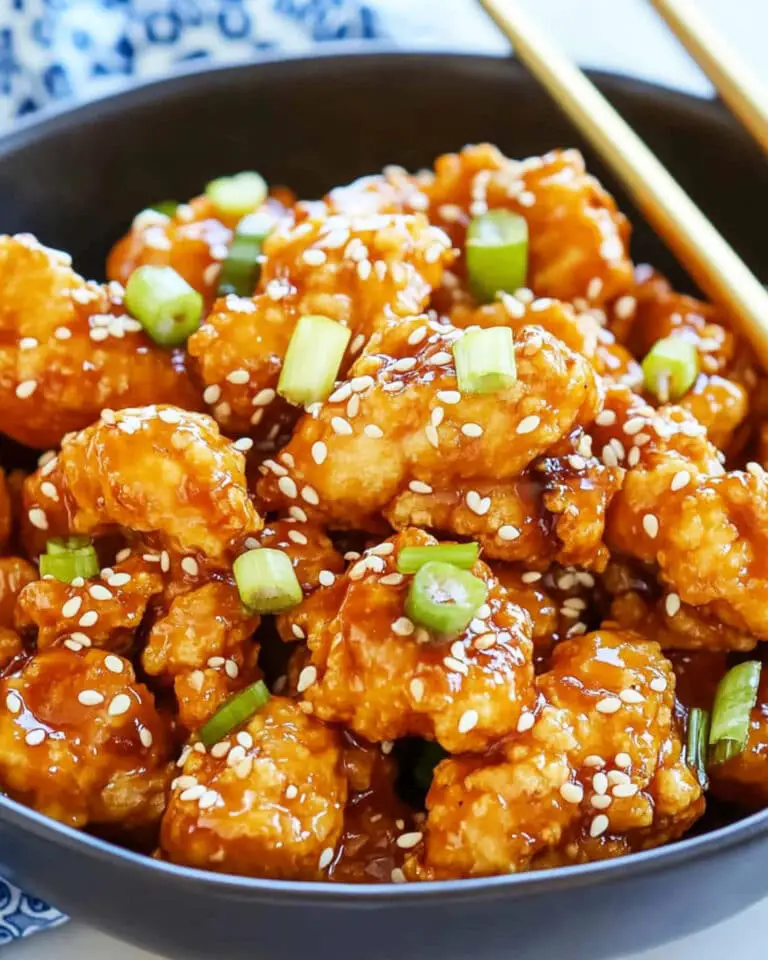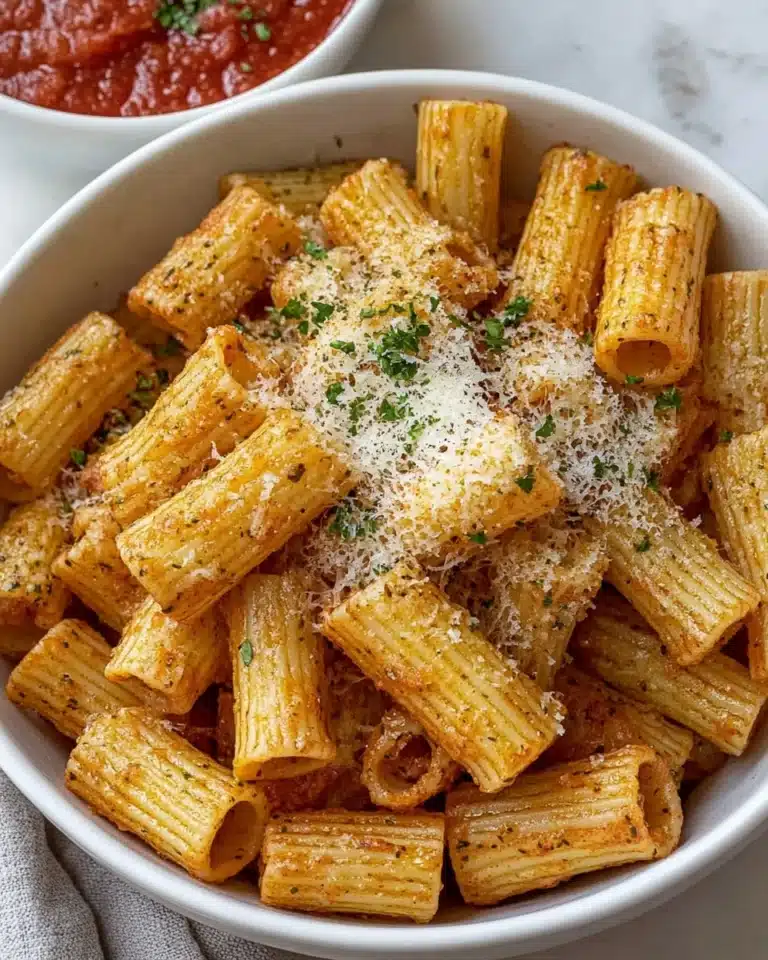If you love the irresistible combination of savory, sweet, and just a hint of heat, get excited for homemade Korean Beef Bulgogi! This iconic dish takes thinly sliced, marinated beef and transforms it into mouthwatering bites with a magical balance of umami flavors that dance on your tongue. It’s a weeknight winner and sure to become your new go-to.
Why You’ll Love This Recipe
- Bursting with Authentic Flavor: Every bite of Korean Beef Bulgogi shines with the sweet, salty, and garlicky marinade found in your favorite Korean restaurants.
- Quick Cook, Big Payoff: After marinating, the beef cooks in just minutes—making it the perfect fast but impressive meal for busy nights.
- Customizable for All Tastes: Whether you prefer extra heat, a little more sweetness, or different proteins, this recipe adapts beautifully to any palate.
- Perfect for Sharing: Serve it up family-style or pile into rice bowls—Korean Beef Bulgogi is guaranteed to make everyone around your table smile.
Ingredients You’ll Need
You don’t need a long list of mysterious ingredients to get true Bulgogi magic at home. Each component in this recipe has a special role, contributing signature flavors, juicy texture, or adding eye-catching color to make Korean Beef Bulgogi unforgettable.
- Flank Steak, Sirloin, Tenderloin, or Ribeye: These cuts are ideal for bulgogi because they’re tender and still hold up to quick grilling. Try to slice the beef as thinly as possible for that signature melt-in-your-mouth bite.
- Soy Sauce (reduced sodium): The base of the marinade—salty, savory, and complex—balances the sweetness of the sugar and pear.
- Rice Vinegar: Adds a gentle acidity that keeps the bulgogi bright and helps tenderize the beef.
- Light Brown Sugar: This is where you get that signature glaze and a touch of caramelized sweetness.
- Sesame Oil: The nutty aroma of sesame oil is unmistakable in Korean cuisine, and it makes this beef truly addictive.
- Garlic & Freshly Grated Ginger: These aromatics punch up the marinade with spiciness and depth—don’t skimp!
- Asian Pear (grated): The secret to tender, juicy beef and authentic bulgogi flavor. If you can’t find Asian pear, a ripe Bosc pear or even apple can do the trick.
- Red Pepper Flakes: Just a pinch lends background warmth—add more if you like extra heat.
- Vegetable Oil: Use a neutral oil for high-heat searing that lets those bulgogi flavors shine.
- Green Onions and Toasted Sesame Seeds: For garnish, adding color and a fresh, toasty finish.
Variations
The beauty of Korean Beef Bulgogi is in how effortlessly you can riff on it—use what you have or make it suit your tastes, and you’ll still get a bowlful of happiness every time. Don’t be afraid to get creative or keep it classic!
- Try Chicken or Pork: Thinly sliced chicken thighs or pork tenderloin are fantastic alternatives when you want to switch up your protein but keep all the Bulgogi charm.
- Go Vegetarian: Swap the beef for extra-firm tofu or thinly sliced mushrooms and marinate as you would the meat—they’ll soak up all that gorgeous flavor.
- Adjust the Heat: Love spice? Add a teaspoon of gochujang (Korean red chili paste) or more red pepper flakes for a bolder kick.
- Make it Gluten-Free: Simply use tamari or certified gluten-free soy sauce and you’re all set for a gluten-free bulgogi night.
How to Make Korean Beef Bulgogi
Step 1: Slice the Steak Paper-Thin
Start by wrapping your steak in plastic wrap and popping it into the freezer for a few hours—a little chill makes it so much easier to slice super thin. Use a sharp knife to cut across the grain into 1/4-inch (or thinner!) slices. These thin strips absorb marinade and cook up unbelievably tender.
Step 2: Whisk Up the Bulgogi Marinade
In a mixing bowl, whisk together soy sauce, rice vinegar, brown sugar, sesame oil, garlic, ginger, grated Asian pear, and red pepper flakes. This is the foundation of the unforgettable Korean Beef Bulgogi flavor, and it’s positively packed with aroma and depth.
Step 3: Marinate the Beef
Add your thinly sliced beef to a large Ziploc bag or a glass dish, then pour the marinade over and give everything a good toss. Press out the excess air and seal. Set in the fridge for at least 2-3 hours, or even better, overnight—longer marinating means more deliciousness!
Step 4: Grill or Sear to Perfection
Heat a cast-iron grill pan (or just a large skillet) over medium-high with a slick of vegetable oil. Working in batches, cook the beef in a single layer—don’t crowd the pan! Sear each side for 2-3 minutes until you get those gorgeous caramelized edges. Repeat as needed to cook all the bulgogi.
Step 5: Garnish and Serve
Transfer the sizzling beef straight onto fluffy steamed rice. Shower with sliced green onions and a sprinkle of toasted sesame seeds for that perfect Korean Beef Bulgogi finish. Serve immediately and get ready for big smiles at the table!
Pro Tips for Making Korean Beef Bulgogi
- Freeze, Then Slice: Chilling your steak in the freezer for a few hours makes it much easier to cut thin, even pieces—a key to super-tender bulgogi.
- Don’t Crowd the Pan: Sear your beef in small batches to get that irresistible caramelization. Overcrowding leads to steaming instead of browning.
- Use Asian Pear for Magic: Don’t skip the grated pear in the marinade; it brings authentic sweetness and an enzyme that tenderizes the beef like nothing else.
- Overnight = Flavor Bomb: If you have time, marinate overnight. The flavors intensify and soak all the way through for the best Korean Beef Bulgogi experience.
How to Serve Korean Beef Bulgogi
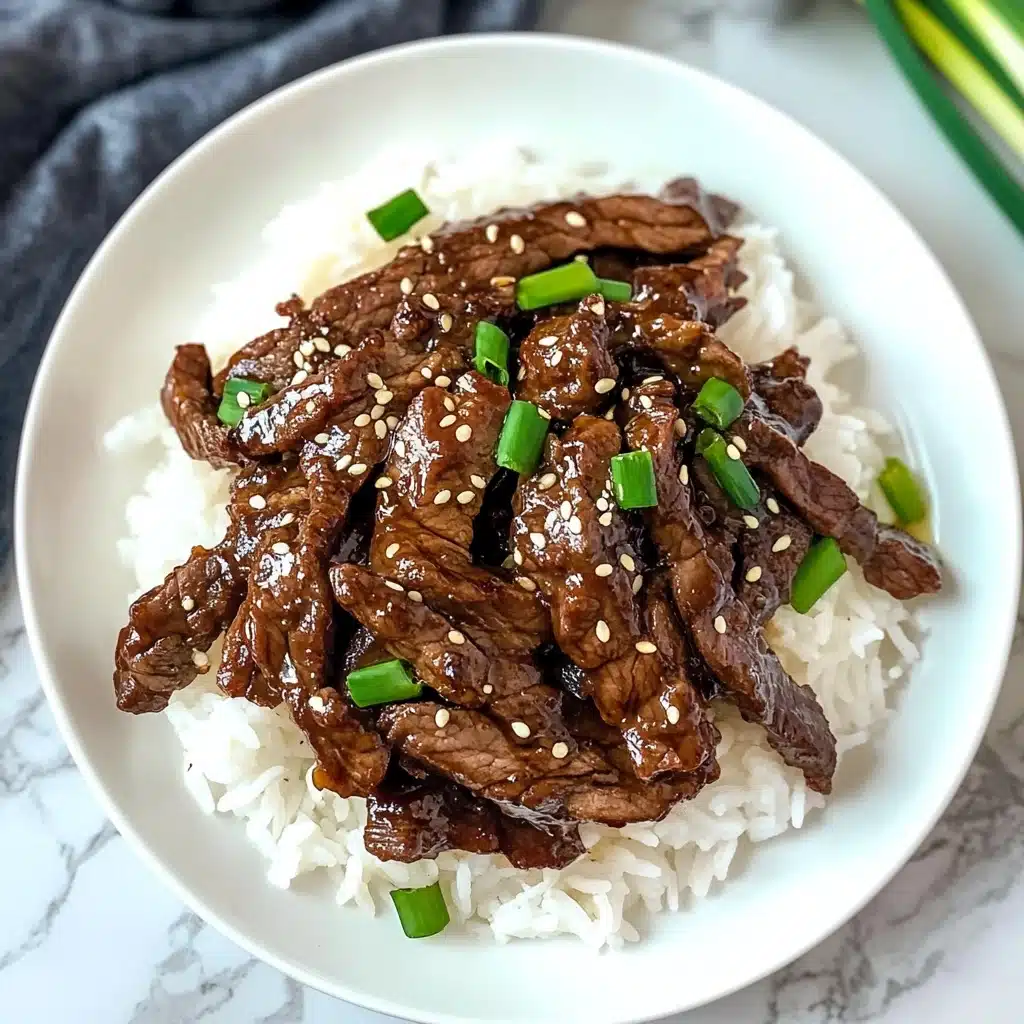
Garnishes
Korean Beef Bulgogi truly shines with a scattering of paper-thin green onions and a sprinkle of toasted sesame seeds right before serving. For extra color and crunch, you can even top with shredded raw carrot or a handful of microgreens—simple touches that add extra pop to every bite.
Side Dishes
Classic steamed short-grain rice is a must for soaking up all that savory-sweet sauce, but don’t stop there! Bulgogi sings when served with kimchi, pickled radish, or sautéed spinach. Try a crisp green salad or Korean-style lettuce wraps for balance and freshness.
Creative Ways to Present
If you want to impress, serve Korean Beef Bulgogi as build-your-own rice bowls with plenty of colorful toppings, or tuck it into warm lettuce leaves with a dab of gochujang for a fun, hands-on dinner. Leftovers? Pile them into tacos or stir into fried rice—a guaranteed crowd-pleaser!
Make Ahead and Storage
Storing Leftovers
Korean Beef Bulgogi is just as wonderful the next day! Cool the cooked beef completely, then transfer to an airtight container and refrigerate for up to 4 days—it actually gets even tastier as those flavors meld.
Freezing
You can freeze uncooked, marinated beef for a lightning-fast future dinner—just thaw it overnight in the fridge before cooking as usual. Cooked bulgogi also freezes beautifully; portion into bags, remove extra air, and freeze for up to 2 months.
Reheating
To reheat, warm the beef gently in a skillet over medium heat until heated through or use a microwave in 30-second bursts. Add a splash of water or extra sauce if it needs a little moisture—just don’t overcook it, so it stays juicy and tender!
FAQs
-
Can I make Korean Beef Bulgogi without Asian pear?
Yes! While Asian pear adds tenderizing enzymes and a touch of authentic sweetness, you can substitute with a ripe Bosc pear, Fuji apple, or even a splash more brown sugar if needed. The flavor will be just as crave-worthy.
-
What’s the best way to slice the beef for bulgogi?
Freeze the steak for 2-3 hours to firm it up, then use a very sharp knife to slice it across the grain into paper-thin strips—this is crucial for the tender texture that makes Korean Beef Bulgogi so special.
-
Can I use a regular frying pan instead of a grill pan?
Absolutely! A heavy-bottomed skillet or any nonstick pan works perfectly. The important part is getting the pan hot, using a bit of oil, and not overcrowding as you sear the meat to get those delicious caramelized edges.
-
Is Korean Beef Bulgogi spicy?
By default, bulgogi isn’t very spicy—it’s more about savory-sweet flavors with just a gentle warmth from red pepper flakes. Add extra chili or gochujang if you’re craving more heat, or skip it altogether for a milder version kids will love!
Final Thoughts
If you’re looking for a meal that’s bursting with flavor, easy to customize, and unfailingly joyful, Korean Beef Bulgogi is it. Gather your ingredients, dive into the simple steps, and savor every juicy, garlicky, sweet bite—you’re going to fall in love with this recipe, guaranteed!
Print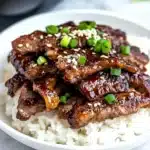
Korean Beef Bulgogi Recipe
- Prep Time: 15 minutes
- Cook Time: 15 minutes
- Total Time: 3 hours
- Yield: 4 servings 1x
- Category: Main Course
- Method: Grilling
- Cuisine: Korean
- Diet: Gluten Free
Description
Korean Beef Bulgogi is a delicious and savory dish featuring thinly sliced, marinated beef that is grilled to perfection. This recipe offers a perfect balance of sweet, salty, and umami flavors that will have your taste buds dancing with delight.
Ingredients
For the Marinade:
- 1/4 cup reduced-sodium soy sauce
- 1 tablespoon rice vinegar
- 3 tablespoons light brown sugar
- 2 tablespoons sesame oil
- 5 cloves garlic, minced
- 1 tablespoon freshly grated ginger
- 1/2 cup Asian pear, grated
- 1/8 teaspoon red pepper flakes
For the Beef:
- 2 pounds flank steak, sirloin, tenderloin, or ribeye
- 2 tablespoons vegetable oil, divided
- 2 green onions, thinly sliced
- 1 teaspoon toasted sesame seeds
Instructions
- Chill the Steak: Wrap the flank steak in plastic wrap and freeze for 3 hours. Slice into 1/4-inch thick slices.
- Marinate: Combine all marinade ingredients in a bowl. Marinate sliced steak for 2-3 hours or overnight.
- Cook: Heat a grill pan, add oil, and cook steak slices in batches until charred, about 2-3 minutes per side.
- Serve over white rice, garnished with green onions and sesame seeds.
Nutrition
- Serving Size: 1 serving
- Calories: 380
- Sugar: 9g
- Sodium: 780mg
- Fat: 18g
- Saturated Fat: 6g
- Unsaturated Fat: 10g
- Trans Fat: 0g
- Carbohydrates: 14g
- Fiber: 1g
- Protein: 38g
- Cholesterol: 110mg

